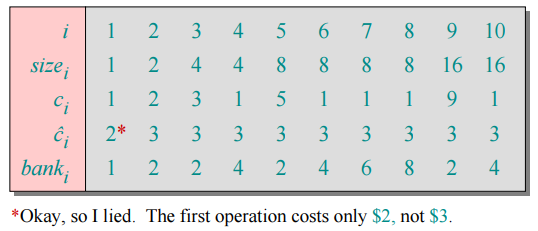平摊分析,表的扩增
How large should a hash table be?
Goal : Make the table as small as possible, but large enough so that it won’t overflow (or otherwise become inefficient).
Problem : What if we don’t know the proper size in advance?
Solution : Dynamic tables
IDEA : Whenever the table gets too full(overflows), “grow” it.
- Allocate(malloc or new) a large table.
- move the items from the old to new.
-
The aggregate method
Analysis :
A sequence of n insertion operations worst-case of 1 insert = O(n)
let ci = the cost of the i-th insertion = i(if i-1 is an exact power of 2)/ 1(otherwise).
Cost of n insertions =
Thus, the average cost of each dynamic-table operation is O(n)/n= O(1)
An amortized analysis(平摊分析) is any strategy for analyzing a sequence of operations to show that the average cost per operation is small, even though a single operation within the sequence might be expensive.
常见的平摊分析技术: the aggregate method(聚集分析)
- the accounting method(记账分析)
- the potential method(势能方法)
The aggregate method, though simple, lacks the precision of the other two methods. In particular, the accounting and potential methods allow a specific amortized cost to be allocated to each operation.
The accounting method
- Charge i th operation a fictitious amortized cost ĉ i, where $1 pays for 1 unit of work (i.e., time).
- This fee is consumed to perform the operation.
- Any amount not immediately consumed is stored in the bank for use by subsequent operations.
- The bank balance must not go negative! We must ensure that:
for all n
Thus, the total amortized costs provide an upper bound on the total true costs.
Accounting analysis of dynamic tables
Charge an amortized cost of ĉi = $3 for the i th insertion.
$1 pays for the immediate insertion.
- $2 is stored for later table doubling.
When the table doubles, $1 pays to move a recent item, and $1 pays to move an old item.

Key invariant : Bank balance never drops below 0. Thus, the sum of the amortized costs provides an upper bound on the sum of the true costs.
The potential method
IDEA : View the bank account as the potential energy (à la physics) of the dynamic set.
Framework :
- Start with an initial data structure
.
- Operation i transforms
to
.
- The cost of operation i is
.
- Define a potenrial function
, such that
and
for all i.
- The amortized cost
with respect to Φ is defined to be
. 其中,
- if ∆Φi > 0, then ĉi > ci. Operation i stores work in the data structure for later use; If ∆Φi < 0, then ĉi < ci. The data structure delivers up stored work to help pay for operation i.
The total amortized cost of n operations is:
例子略
Conclusions
- Amortized costs can provide a clean abstraction of data-structure performance.
- Any of the analysis methods can be used when an amortized analysis is called for, but each method has some situations where it is arguably the simplest or most precise.
- Different schemes may work for assigning amortized costs in the accounting method, or potentials in the potential method, sometimes yielding radically different bounds.

